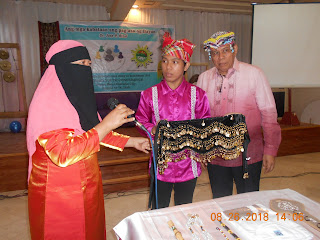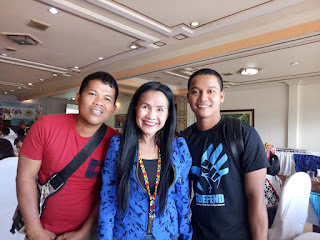Project title: Kabatanonan alang sa Kalambuan 2018
Sub-Title: IP-Moro Youth Summit
Participants: 40 Indigenous
Peoples Youth
40 Moro Youths
Date: August 24-26 2018
Venue: Taipan Hotel Valencia City
Grantee: Federation
of Tribal Youth Council
National Agency: National Commission for Culture and the Arts
Report about Kabatanonan alang sa Kalambuan 2018 Project
This report examines the
Kabatanonan alang sa Kalambuan 2018 initiative—a youth empowerment and
peace-building program in Mindanao—and outlines its relevance to a potential National
Commission for Culture and the Arts. By analyzing the project’s objectives,
methods, and outcomes, this report demonstrates how its core elements align
with NCCA’s mission to safeguard children’s rights, promote inclusive
development, and nurture resilient communities.
1. Overview of Kabatanonan alang sa Kalambuan 2018
Kabatanonan alang sa Kalambuan
2018 (Youth for Progress 2018) was designed to foster unity, leadership, and
peace among indigenous peoples (IP) and Moro youths in Mindanao. Originating
from a rich cultural context—with beneficiaries drawn from diverse tribes such
as the Kirenteken, Donggoanon, Talaandig, Pulangihon, Ilantongon, Higaonon, and
Manobo—the project brought together youth from historically conflicted
communities. Through a series of activities including friendship exchanges,
interactive rating exercises on community closeness, ritual covenants, cultural
performances, and reflective sessions, the initiative aimed to bridge divides
and empower participants to become future leaders in peace and development.
2. Core Objectives and Activities
The
project was built upon several key objectives:
- Cultural and Historical
Awareness:
Participants learned about ancestral figures like Apo Mamalo and Apo
Tabunaway, as well as the importance of customary laws and traditions.
- Perception and Dialogue: Activities encouraged
participants to assess their present conditions, explore the roots of
intergroup tension, and brainstorm solutions to restore brotherhood.
- Leadership Development: Through identifying and
engaging youth leaders from both IP and Moro communities, the initiative
fostered leadership skills vital for community transformation.
- Peace-building: Emphasizing that war is not
a solution, the project actively promoted dialogue, mutual respect, and
reconciliation.
- Community Integration: Structured activities—such
as mixed “list of friends” exchanges and cultural nights—facilitated
inter-cultural understanding and trust-building.
These
elements were practically implemented over a multi-day event that included
structured discussions, rituals, and celebratory cultural showcases.
3. Alignment of Mandates
Core
priorities include the protection of children’s rights, youth empowerment,
education, and the fostering of peaceful, inclusive communities. Kabatanonan
alang sa Kalambuan 2018 aligns with these priorities in several critical ways:
Youth Empowerment and Leadership
- Capacity Building: By equipping participants
with leadership skills and knowledge about their cultural heritage, the
project reinforces emphasis on empowering young people to be agents of
change in their communities.
- Voice and Participation: The initiative created safe
spaces for youths to articulate their thoughts, dreams, and concerns,
resonating with UNICEF’s commitment to ensuring that young people have a
voice in decisions affecting their lives.
Peace-building and Conflict Resolution
- Intergroup Dialogue: The project actively
addressed historical grievances and fostered inter-cultural dialogue
between IP and Moro youths. This approach is central to conflict-affected
areas, where building trust and reconciliation is paramount.
- Cultural Integration: By celebrating diverse
cultural practices and promoting mutual understanding, the initiative
contributes to a framework for peaceful coexistence—a key element and
strategy to reduce violence and promote stability.
Community Resilience and Inclusive Development
- Grassroots Engagement: The participatory methods
used in Kabatanonan alang sa Kalambuan 2018 serve as a model for
community-led development. Such grassroots engagement is critical to programs
that are responsive to local needs.
- Holistic Approach: The project’s integration
of cultural, social, and educational components aligns with multisectoral
approach to child and youth development, ensuring that interventions are
both culturally sensitive and broadly impactful.
4. The insights and experiences gained from
Kabatanonan alang sa Kalambuan 2018 can help:
Program Design and Scaling: The project’s
methodology—emphasizing dialogue, cultural exchange, and participatory
leadership development—can serve as a blueprint for scaling similar initiatives
across conflict-affected or marginalized regions.
- Best Practices in
Peace-building:
Lessons learned from facilitating intergroup interactions and managing
sensitive discussions can help shape peace-building among youth, ensuring
that programs are both effective and respectful of cultural differences.
- Community Engagement
Frameworks: The
initiative’s success in mobilizing local youth leaders and integrating
traditional practices into modern development discourse offers valuable
insights for creating sustainable, community-driven programs.
- Policy Recommendations: The project provides a case
study on how culturally grounded, youth-focused interventions can
contribute to broader peace and development objectives. Such evidence can
inform policy recommendations and strategic planning within NCCA and
partner organizations.
5. Conclusion
Kabatanonan
alang sa Kalambuan 2018 embodies a comprehensive approach to youth empowerment,
cultural preservation, and peace-building—all of which are central to NCCA.
By fostering intercultural dialogue, nurturing leadership, and engaging communities
in sustainable development, the initiative offers practical insights and proven
methodologies that can enrich the NCCA. Embracing the lessons from this project
can lead to the design of more effective, culturally responsive programs that
empower youth and build resilient communities in regions facing conflict and
marginalization.
This
report demonstrates that the principles and practices of Kabatanonan alang sa
Kalambuan 2018 are not only relevant but also highly instructive for youth
empowerment and peace-building initiatives.



















.jpg)























































































.jpg)






























.jpg)









.jpg)






.jpg)





























.jpg)

























.jpg)

No comments:
Post a Comment